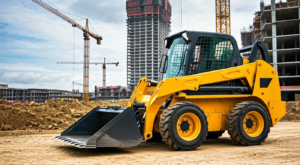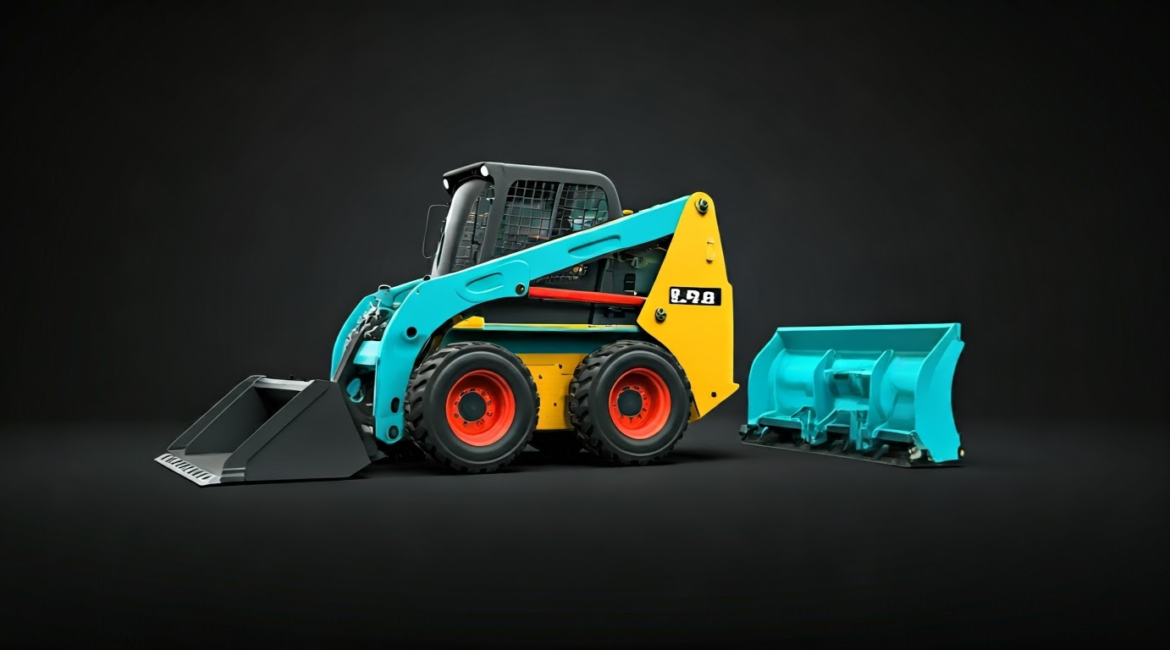Choosing the suitable bucket for the work will assist you to maximize the skid steer loader’s versatility. The right bucket will save time and effort regardless of your activity—gardening, constructing, or simply proud skid steer owner working on a big project.
Three basic bucket kinds and their best applications will be discussed in this book. By the end, you’ll know exactly which bucket to reach for, no matter the task.

Essential Skid Steer Features
Skid steer loaders are well-known for their versatility and performance since they possess several significant properties that make them indispensable tools in many different fields. You should consider these among the most crucial elements:
- Compact Design: Skid steers are made to run in confined areas where more general equipment cannot. For urban building, landscaping, and other jobs in limited areas, their little footprint makes them perfect.
- Versatile Attachments: A skid steer’s usefulness is much improved by being able to alternate among several attachments—buckets, augers, forks, or grapples. This flexibility lets one machine effectively handle a broad spectrum of chores.
- High Maneuverability: Skid steers give great agility with its zero-turn radius and exact controls. This lets workers easily undertake delicate or detailed work even in demanding surroundings.
- Durable Build: Strong frames, heavy-duty hydraulics, and premium components guarantee that skid steers can resist demanding operating conditions and long use.
- Simple Maintenance: Easy access to key components, such as the engine and hydraulics, makes regular maintenance quick and hassle-free, reducing downtime and keeping the machine running efficiently.
By understanding these essential features, operators can fully leverage the capabilities of their skid steer loader, ensuring maximum productivity and reliability.
1. General Purpose Bucket
Overview:
Many owners of skid steer go to the general-purpose bucket for attachment. Its simple yet effective design qualifies it as a flexible answer for many daily tasks. From construction sites to backyards, this bucket forms the backbone of every skid steer operation.
Common Uses:
- Perfect for dragging and lifting sand, mud, or small stones from one location to another.
- carrying tools and materials. From mulch to compost, this bucket promises quick and minimal effort movement of objects.
- Dumping loads: Move bulky items to waiting cars for removal or create mounds from them easily.
Perfect For:
Property owners overseeing routine maintenance, landscapers working on level ground, and builders establishing task sites.
2. Rock Bucket
Overview:
The rock bucket is precision-made for rugged use and is especially effective for handling debris. Designed with tines or grated openings, this bucket allows smaller materials like sand or soil to pass through while retaining larger objects.
Common Uses:
- Good separation of dirt from pebbles, debris, and other undesired objects leaves clean, usable substance.
- Land clearance is ideal for areas covered in stones, dropped branches, and roots.
- Eliminate larger rubbish from areas where the soil stays behind
Best For:
Contractors laying construction foundations, landscapers working on rocky ground, and everyone tasked to clear property for development or clean-up following significant events.
3. Grapple Bucket
Overview:
Particularly for lifting odd, heavy, or awkward materials like logs or shrubs, the grapple bucket principles apply. With hydraulic grapple arms, this bucket efficiently “grabs” items to prevent anything from sliding out on route.
Common Uses:
- Perfect for transferring logs to either storage or disposal sites is moving cut or fallen logs.
- Lift and remove effortlessly heaps of yard waste, tree stumps, or brushes.
- From job sites, rapidly move big, uneven objects—broken concrete or twisted rebar.
Best For:
Landscape designers working on major property restoration projects, demolition firms handling cleansing, and forestry experts clearing significantly wooded areas.
How to Choose the Right Bucket
Use these guidelines to help you choose the bucket for a project:
- Evaluate your material: Find out what kind and quantity you will be moving. A general-purpose bucket performs admirably for smaller, homogeneous weights. Go for the grapple bucket for big, irregular objects.
- Exist the Terrain: Where rocky or debris-heavy environments call for sifting, rock buckets are very necessary.Consider beginning with a general-purpose bucket and adding specialist buckets as needed if you will be routinely addressing a combination of chores.
Final Thoughts
The bucket you choose for your skid steer loader can make or break your job. Choosing the correct attachment for your needs will save time, increase output, and lower equipment wear and tear.
Now is the time to invest if you are a skid steer owner, landscaper, or construction worker trying to improve the bucket game of your loader. Your preferred bucket for the task is which one? Drop your ideas into the comments. Let’s keep talking and assist others in selecting the ideal bucket for their next project. Good excavation!
Additional Tips for Skid Steer Owners
- Look at your bucket often for wear and tear or damage. As necessary to guarantee best performance, replace or fix.
- To increase the capacity of your skid steer loader, think about making investments in attachments including pallet forks, trenchers, and augers.
- When utilizing accessories and running your skid steer loader, always follow manufacturer instructions and safety procedures.
- Maintaining current on new technologies and skid steer industry advances will help you to always raise the efficiency and effectiveness of your equipment.

